0%
20Chapters
0-1Hours read
0kTotal Words
Book Description
Apache Cassandra is the most commonly used NoSQL database written in Java and is renowned in the industry as the only NoSQL solution that can accommodate the complex requirements of today's modern line-of-business applications. Cassandra is the technology of choice for such data-driven organizations as Netflix, eBay, Constant Contact, Comcast, and scores of others. In NOSQL WEB DEVELOPMENT WITH APACHE CASSANDRA, you will learn about all aspects of using Cassandra in web applications--including accessing the Cassandra database using the common programming/scripting languages Java, PHP, Ruby, and JavaScript. Master web development using Apache Cassandra with the help of NOSQL WEB DEVELOPMENT WITH APACHE CASSANDRA
Table of Contents
- Title Page
- Copyright Page
- About the Author
- Contents
- Introduction
- Part I Java Clients
- Chapter 1 Using Cassandra with Hector
- Cassandra Storage Model
- Overview of Hector Java Client
- Setting the Environment
- Creating a Java Project
- Creating a Cassandra Cluster Object
- Creating a Schema
- Creating a Keyspace
- Creating a Template
- Adding Table Data
- Adding a Single Column of Data in a Table
- Adding Multiple Columns of Data in a Table
- Retrieving Table Data
- Updating Data
- Deleting Table Data
- The HectorClient Class
- Summary
- Chapter 2 Querying Cassandra with CQL
- Overview of CQL
- Setting the Environment
- Creating a Java Project
- Creating a Keyspace
- Creating a Column Family
- Using the INSERT Statement
- Using the SELECT Statement
- Creating a Secondary Index
- Using the SELECT Statement with the WHERE Clause
- Using the UPDATE Statement
- Using the BATCH Statement
- Using the DELETE Statement
- Using the ALTER COLUMNFAMILY Statement
- Dropping the Column Family
- Dropping the Keyspace
- The CQLClient Application
- New Features in CQL 3
- Summary
- Chapter 3 Using Cassandra with DataStax Java Driver
- Overview of DataStax Java Driver
- Setting the Environment
- Creating a Java Project
- Creating a Connection
- Overview of the Session Class
- Creating a Keyspace
- Creating a Table
- Running the INSERT Statement
- Running a SELECT Statement
- Creating an Index
- Selecting with SELECT and a WHERE Filter
- Running an Async Query
- Running a PreparedStatement Query
- Running the UPDATE Statement
- Running the DELETE Statement
- Running the BATCH Statement
- Dropping an Index
- Dropping a Table
- Dropping a Keyspace
- The CQLClient Application
- Summary
- Chapter 1 Using Cassandra with Hector
- Part II Scripting Languages
- Chapter 4 Using Apache Cassandra with PHP
- An Overview of Phpcassa
- Setting the Environment
- Creating a Keyspace
- Creating a Column Family and Connection Pool
- Adding Data
- Adding Data in a Batch
- Retrieving Data
- Getting Selected Columns
- Getting Columns from Multiple Rows
- Getting Column Slices
- Getting a Range of Rows and Columns
- Updating Data
- Deleting Data
- Dropping the Keyspace and Column Family
- Summary
- Chapter 5 Using a Ruby Client with Cassandra
- Setting the Environment
- Installing a Ruby Client with Cassandra
- Creating a Connection
- Creating a Keyspace
- Creating a Column Family
- Adding Data to a Table
- Adding Rows in Batch
- Retrieving Data from a Table
- Selecting a Single Row
- Selecting Multiple Rows
- Iterating over a Result Set
- Selecting a Range of Rows
- Using a Random Partitioner
- Using an Order-Preserving Partitioner
- Getting a Slice of Columns
- Updating Data in a Table
- Deleting Data in a Table
- Updating a Column Family
- Dropping a Keyspace
- Summary
- Chapter 6 Using Node.js with Cassandra
- Overview of Node.js Driver for Cassandra CQL
- Event-Driven Logging
- Mapping Data Types
- Setting the Environment
- Creating a Connection with Cassandra
- Adding Data to a Table
- Retrieving Data from a Table
- Filtering the Query
- Querying with a Prepared Statement
- Streaming Query Rows
- Streaming a Field
- Streaming the Result
- Updating Data in Table
- Deleting a Column
- Deleting a Row
- Summary
- Chapter 4 Using Apache Cassandra with PHP
- Part III Migration
- Part IV Java EE
- Chapter 9 Using Cassandra with Kundera
- Chapter 10 Using Spring Data with Cassandra
